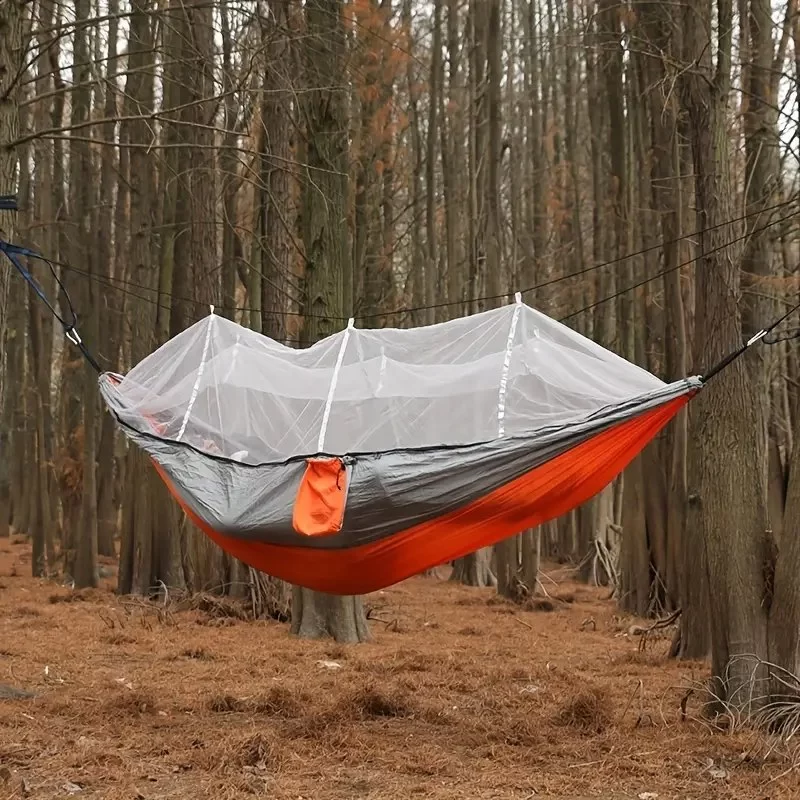- why-portable-camping-hammocks-with-mosquito-nets-are-essential
- key-features-to-look-for-in-a-camping-hammock-with-net
- how-to-choose-the-right-hammock-for-your-camping-style
- real-life-experiences-from-campers-who-swear-by-hammocks
- pro-tips-for-setting-up-and-maintaining-your-hammock
1. Why Portable Camping Hammocks with Mosquito Nets Are Essential
Camping under the stars is magical—until the mosquitos show up. That’s why portable camping hammocks with mosquito nets are a game-changer for outdoor lovers. These all-in-one systems provide a comfortable, elevated place to rest while keeping bugs at bay. Whether you're deep in the forest, lounging by a lake, or backpacking through national parks, a hammock with an integrated net means peaceful, bite-free sleep.
Unlike tents, which often require level ground and more setup time, hammocks are flexible, lightweight, and quick to deploy. Add a mosquito net, and you get the same protection without compromising on the open-air experience. It’s comfort, convenience, and protection rolled into one.
2. Key Features to Look for in a Camping Hammock with Net
2.1 Durable and Lightweight Material
The best portable camping hammocks are made from parachute nylon or ripstop polyester—materials known for their strength-to-weight ratio. These fabrics are breathable, quick-drying, and built to endure harsh environments without weighing down your pack.
2.2 Integrated Mosquito Net Design
Look for a hammock with a sewn-in mosquito net rather than a detachable one. This ensures full enclosure with minimal effort. Fine mesh is critical; it should block even the tiniest bugs, not just big mosquitoes. Double-sided zippers allow for easy entry and exit, while keeping the net secure throughout the night.
2.3 Suspension System and Tree Straps
A strong, adjustable suspension system is essential. Good hammocks come with tree-friendly straps that distribute weight evenly without damaging bark. Metal carabiners and triple-stitched seams increase security, giving you confidence when suspended between trees.
2.4 Ventilation and Comfort
Proper airflow is often overlooked. Choose a hammock design that allows for good cross-ventilation even when zipped up. Some premium models include ridge lines that keep the net elevated, preventing it from touching your face while you sleep. Small design upgrades like internal pockets and gear loops can also elevate your camping experience.
3. How to Choose the Right Hammock for Your Camping Style
3.1 Solo Backpackers
If you're a minimalist hiker, look for ultralight hammocks that pack down small but still include a full insect net. Every ounce counts when you're climbing elevation, and models under 2 pounds with quick-deploy systems are ideal. Avoid overly complex setups that waste daylight.
3.2 Family or Group Campers
Those camping with kids or groups may prefer double hammocks with higher weight capacity and wider sleeping area. Some models allow for two people while maintaining full bug protection. Look for easy assembly and extra-long straps for versatile setup in different terrains.
3.3 All-Season Explorers
For those who camp year-round, a four-season hammock setup with a mosquito net and optional rainfly is essential. Look for models that support underquilts and insulation layers, ensuring comfort even in colder months. Brands that specialize in modular systems often provide the most flexibility.
4. Real-Life Experiences from Campers Who Swear by Hammocks
Ben and Alisha, a couple who spent six months trekking through the Appalachian Trail, credit their hammock setup with keeping them bug-free and well-rested. “There were nights when our friends were swatting mosquitoes inside tents, and we were swinging comfortably, mosquito net zipped tight,” Alisha shares.
Jake, an off-grid camper in the Pacific Northwest, found his favorite model through Pine Cliff Resort. “The mosquito net is a game changer in the backwoods. It’s breathable, roomy, and sets up in under five minutes. Honestly, I can’t go back to tents.”
These real-world examples highlight why hammocks with mosquito nets are not just trendy—they’re practical. From thru-hikers to weekend warriors, the comfort and protection they offer have become essential for many outdoor lifestyles.
5. Pro Tips for Setting Up and Maintaining Your Hammock
5.1 Finding the Right Spot
Always choose trees that are alive, healthy, and roughly 12-15 feet apart. Avoid setting up near dead branches or over rocky ground. Try to hang the hammock at about chair height to make getting in and out easier.
5.2 Tension and Angle
The ideal hang angle is around 30 degrees from horizontal. This provides enough sag for a flat lay and reduces pressure on the suspension system. Overly tight setups can cause discomfort and reduce the lifespan of your gear.
5.3 Cleaning and Storage
After each trip, shake out debris and air-dry your hammock completely before storing. Clean it gently with mild detergent, avoiding harsh chemicals that can weaken the fabric. Regularly inspect zippers and seams for wear. Store in a dry, breathable bag to prevent mildew.
5.4 Trusted Gear from the Right Place
When it comes to finding reliable portable camping hammocks with mosquito nets, it’s worth trusting curated platforms that understand outdoor gear. Pine Cliff Resort not only offers a range of trusted models, but also provides personalized recommendations based on your camping style. It’s the go-to resource for campers who want function without compromise.







